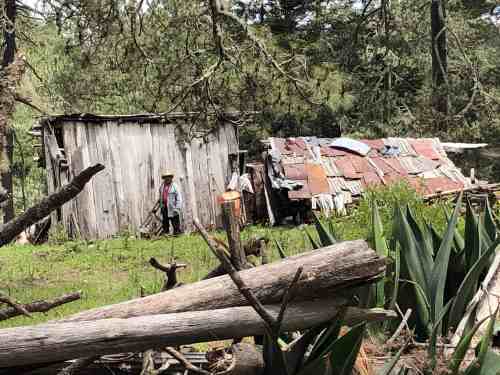My friend Debbie has been here for a week with her granddaughter in a Spanish immersion class. She’s a medical doctor. I discovered (in addition to curing me of my intestinal ailments) she knows all the Latin botanical names for mushrooms, since she likes to hunt them in the forests near her North Carolina home. So, I decided we needed a trip to the wild mushroom village of San Antonio Cuajimoloyas, up the mountain from Teotitlan del Valle in the Sierra Juarez.

I’m going to miss the Wild Mushroom Festival there this year, but wanted to cook and eat hongos silvestres before I leave Oaxaca for a while on July 10. Debbie, who has been eating out all week and is a great cook, jumped at my offer to take us to the mushroom village and offered to prepare any mushrooms we found for dinner. Granddaughter likes pizza and pasta. Dinner would be spaghetti topped with sauteed mushrooms and garnished with hard cheese. Hold the mushrooms for the pre-teen.

(Note: Hongos are different than champiñones, the common button mushroom that we find in all our USA supermarkets. Hongos are truly wild, uncultivated, and you have to know what you are doing to pick and eat them.)

It’s about a 40-minute drive up the mountain from Tlacolula to an altitude of 3,200 meters. That’s 10,400 feet, about 4,000+ feet higher than the Tlacolula Valley. We drive through Teotitlan del Valle and San Miguel del Valle community lands. At a mirador, we stop to see Teotitlan del Valle just below us.


When we arrive about 10:45 a.m. it’s chilly. Er, actually, it’s COLD. I was in three layers of lightweight cotton and could have used a warm wool sweater and a hat. Mittens might have been in order. A breeze made it even chillier.


I decided to stop at the ecotourism center. We joked about doing a Zip Line and then bailed on the idea, opting for a walk through the forest instead. Rather than doing it on our own, we arranged guide services, which cost 200 pesos for two- to three- hours and definitely worth it. It supports the town’s ecotourism and the people who are committed to preserving the natural environment.


Meet Manuel, who’s mom owns a tiny convenience store and comedor at the entrance to town. He was our leader, equipped with a walkie-talkie and knowledge of local vegetation. Manuel took us into areas I had never been before, up and over barbed wire fencing, through wildflower meadows and fields of grazing goats.



As we walked, we warmed up. Now, closer to noon, the clouds had moved away and while it was still chilly, it was comfortable since the first hour of the walk was horizontal or downhill. I noted that what goes down must come up. And the last 45-minutes to hike out of the community-owned forest was a struggle for me at this altitude, even though I’m now a seasoned walker!



I pulled the soy grande card and asked Manuel if he would rescue us from the remaining 30- minute grand finale stretch laid out before us at a 90-degree incline. I handed him my car keys. By then, we were on the road between Cuajimoloyas and Llano Grande. I had to stop every five minutes to catch my breath. I’m reconsidering going to Peru!




However, the walk is glorious and the upcoming Feria de Hongos promises to be even more than it was when I attended last year.

We finished the day eating a comida of tasajo and quesadillas at the comedor, completely satisfied with the adventure, and left town with a big bag of wild mushrooms, and locally grown organic potatoes, apples and peaches.









